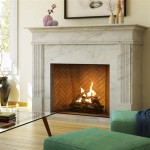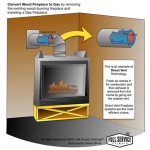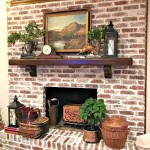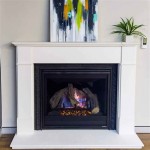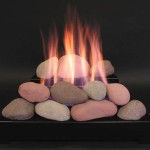Understanding Fireplace Gas Logs: A Comprehensive Guide
Fireplace gas logs offer a convenient and aesthetically pleasing alternative to traditional wood-burning fireplaces. They provide the visual appeal of a real fire without the associated labor of sourcing, stacking, and tending to wood. This article aims to provide a comprehensive understanding of fireplace gas logs, covering their types, benefits, installation, maintenance, and safety considerations.
Types of Fireplace Gas Logs
Gas logs are primarily categorized based on the type of gas they utilize: natural gas and propane. The choice between these two types depends on the existing gas infrastructure in the building. Converting from one type to another typically requires professional assistance and may necessitate changes to the gas supply line and burner system.
Natural Gas Logs: Natural gas logs are designed to operate on natural gas lines, which are commonly found in urban and suburban areas. Natural gas is generally more affordable than propane, making it a cost-effective option for frequent fireplace use. Natural gas burns cleaner than propane, producing less soot and fewer emissions.
Propane Gas Logs: Propane gas logs are suited for homes that do not have access to a natural gas line. Propane is typically stored in a tank located outside the house. While propane combustion can produce slightly more soot compared to natural gas, modern propane gas log sets are designed to minimize emissions. Propane tanks need to be periodically refilled, adding to the overall cost of operation.
Beyond the type of gas, gas logs can also be classified based on their venting requirements. Venting refers to the method by which combustion byproducts are expelled from the fireplace.
Vented Gas Logs: Vented gas logs require a fully functional chimney or vent to safely exhaust the combustion gases, including carbon monoxide and water vapor. These logs produce a taller, more realistic flame and generate more heat than ventless models. However, a significant portion of the heat escapes through the chimney, reducing the overall heating efficiency. Vented systems are generally considered safer due to the complete removal of combustion byproducts from the living space.
Ventless Gas Logs: Ventless gas logs, also known as vent-free gas logs, do not require a chimney or vent. They are designed to burn very efficiently, minimizing the production of carbon monoxide. However, they release a small amount of water vapor and other byproducts into the room. These logs are equipped with oxygen depletion sensors (ODS) that automatically shut off the gas supply if oxygen levels in the room drop too low. While ventless logs are more energy-efficient, they require careful monitoring of indoor air quality and adherence to strict safety guidelines. They are often prohibited in certain jurisdictions due to safety concerns.
The material used in the construction of gas logs also influences their appearance and durability. Ceramic logs are highly realistic and durable, able to withstand high temperatures for extended periods. Refractory cement logs are another option, offering good heat retention and a realistic look, but they may be slightly less durable than ceramic logs. Some manufacturers also use lightweight materials like molded concrete or fiberglass for decorative elements.
Benefits of Using Fireplace Gas Logs
Fireplace gas logs offer a range of advantages over traditional wood-burning fireplaces, contributing to convenience, safety, and environmental considerations.
Convenience: Gas logs eliminate the need to source, stack, and transport firewood. Starting a fire is as simple as turning a knob or pressing a button, and the fire can be extinguished instantly. This ease of use makes gas logs an appealing option for individuals seeking a low-maintenance fireplace solution. There is no ash to clean up, reducing the time and effort spent on fireplace upkeep.
Safety: Gas logs reduce the risk of chimney fires and sparks escaping the fireplace, which are common hazards associated with wood-burning fireplaces. The controlled burn of gas logs minimizes the production of creosote, a flammable substance that can accumulate in chimneys and lead to fires. Oxygen depletion sensors (ODS) in ventless models provide an additional layer of safety by shutting off the gas supply in the event of inadequate ventilation.
Environmental Considerations: Gas logs generally produce fewer emissions than wood-burning fireplaces, contributing to improved air quality. The combustion of natural gas or propane releases less particulate matter and carbon monoxide compared to burning wood. While ventless models release some combustion byproducts into the room, the overall environmental impact is typically lower than that of wood-burning fireplaces, especially when considering the sourcing and transportation of firewood.
Aesthetics: Gas logs are designed to mimic the appearance of real wood logs, providing the visual appeal of a traditional fire. Manufacturers offer a variety of log styles, sizes, and arrangements to suit different fireplace designs. The flames produced by gas logs can be adjusted to create a desired ambiance, from a gentle glow to a roaring fire.
Cost-Effectiveness: While the initial cost of purchasing and installing gas logs may be higher than that of a wood-burning fireplace, the long-term operating costs can be lower, particularly for frequent fireplace users. Natural gas is generally more affordable than firewood, and the consistent heat output of gas logs can help reduce heating bills. The reduced maintenance requirements of gas logs also contribute to long-term cost savings.
Installation, Maintenance, and Safety
Proper installation, regular maintenance, and adherence to safety guidelines are essential for ensuring the safe and efficient operation of fireplace gas logs.
Installation: The installation of gas logs should always be performed by a qualified professional. This includes connecting the gas line, installing the burner system, and positioning the logs according to the manufacturer's instructions. Improper installation can lead to gas leaks, carbon monoxide poisoning, and other safety hazards. A professional installer will ensure that the gas log set is compatible with the existing fireplace and gas supply.
Maintenance: Regular maintenance is crucial for maintaining the efficiency and safety of gas logs. This includes cleaning the logs and burner system annually to remove dust, soot, and debris. Check the burner ports for blockages and clean them with a wire brush or compressed air. Inspect the gas lines and connections for leaks using a soapy water solution. If any leaks are detected, immediately shut off the gas supply and contact a qualified technician.
Safety Precautions: Never use gas logs in a fireplace that is not designed for gas use. Always follow the manufacturer's instructions for operation and maintenance. Install and maintain a carbon monoxide detector in the vicinity of the fireplace. Ensure adequate ventilation when using ventless gas logs. Never store flammable materials near the fireplace. Keep children and pets away from the fireplace when it is in operation. Periodically inspect the fireplace and chimney for any signs of damage or deterioration.
Venting Considerations: For vented gas logs, ensure that the chimney is clean and in good working order. Have the chimney inspected and cleaned annually by a qualified chimney sweep. Check the damper to ensure that it opens and closes properly. Never block or obstruct the chimney flue. For ventless gas logs, carefully monitor indoor air quality and ensure adequate ventilation. Open a window or door slightly when using ventless logs to allow for air circulation. Do not use ventless logs in small or poorly ventilated rooms.
Log Placement: Proper log placement is crucial for ensuring efficient burning and preventing damage to the logs and burner system. Follow the manufacturer's instructions for arranging the logs. Do not stack the logs too tightly, as this can restrict airflow and cause incomplete combustion. Ensure that the logs are not blocking the burner ports. Replace any cracked or damaged logs promptly to prevent gas leaks and other safety hazards.
Gas Line Safety: Regularly inspect the gas line for leaks and damage. If you smell gas, immediately shut off the gas supply and contact a qualified technician. Never attempt to repair a gas line yourself. Keep the area around the gas line clear of obstructions. Protect the gas line from physical damage. Consider installing a gas shut-off valve near the fireplace for added safety.
Professional Inspections: Schedule regular professional inspections of the gas log system, including the gas line, burner system, and chimney (for vented models). A qualified technician can identify potential problems and perform necessary repairs or adjustments to ensure the safe and efficient operation of the fireplace. These inspections are particularly important for older gas log systems, as they may be more prone to leaks and other issues.
In conclusion, fireplace gas logs offer a convenient and aesthetically pleasing alternative to wood-burning fireplaces. However, proper installation, regular maintenance, and adherence to safety guidelines are essential for ensuring their safe and efficient operation. By understanding the different types of gas logs, their benefits, and the necessary safety precautions, homeowners can enjoy the warmth and ambiance of a fireplace without the associated hazards and inconveniences of burning wood.

Napoleon Gl18e Vented Gas Log Set 18 Inch

American Gas Log Dundee Oak 30 In Vented Natural Fireplace Set With Complete Kit Manual Match Lit Do30hdmtch The Home Depot

Pleasant Hearth 18 Dual Fuel Wildwood Vent Free Gas Log Set 30 000 Bt

Majestic Vdy Duzy Series Vented Gas Log Set

Napoleon Gl28 Reversible Vented Gas Log Set 28 Inch

Vented Gas Logs Heater Or Decorative Bart Fireside

Real Fyre 24 White Birch Gas Log Set Us Fireplace

Kingsman Glvf24 Log18 18 Inch Vent Free Split Oak Gas Log Set

Vented Gas Logs Natural And Propane

How Long Do Gas Logs Last To Replace Fireplace



